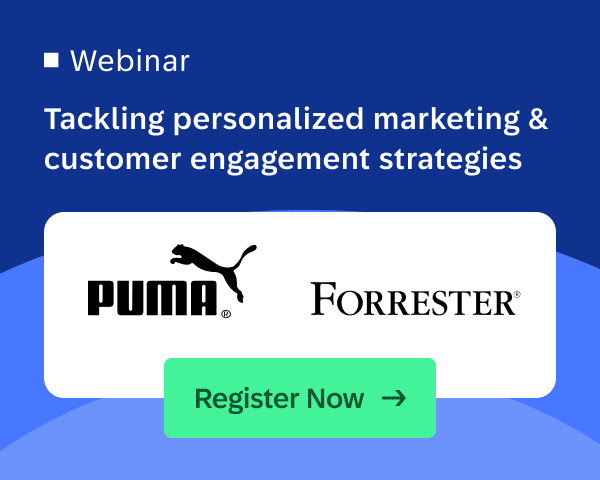While there are many different methods of personalization, especially in the e-commerce world, website personalization is by far one of the most powerful.
Website personalization refers to the process of delivering tailored experiences to visitors based on their unique preferences, as oppose to providing a uniformed experience for all visitors on the site. Ultimately, this helps brands provide visitors with the content they are looking for, better address their needs and boost engagement.
Companies can create these predictions based on big data such as buyer persona, customer preferences, and the stage they’re at in the buying journey. Marketers can then automatically tailor a site in real-time.
The goal of website personalization is to create a more relevant website for consumers, thus leading to longer visit duration time, more product views, boosted site visits and, eventually, increased purchases. This in turn results in a higher order value, revenue and conversions.
We want to set the record straight on website personalization. This article will tell you exactly what website personalization is by explaining the benefits, strategies, different types, and what you’ll need to be successful. Read on to learn how website personalization can help your business reach new heights.
Key Benefits of Website Personalization
So, we know that website personalization can help marketers by addressing visitors in an individual and effective way, while also helping them reach their set of goals at a quicker pace. Let’s break it down a little further – here are some of the ways marketers will benefit from successful website personalization.
Build Brand Loyalty
Personalizing your website will improve interaction with customers and strengthen the relationship that they have with your brand both online and offline. When you gather relevant data – from customer interactions with your website – you can then tailor the type of message you send to other channels and create the type content that best resonates with that customer. This allows you to develop a marketing strategy that is much more personal and effective across channels.
Nurture & Engage Users
You might already be familiar with the concept of email nurturing. Website personalization allows you to nurture customers on the web by extending conversations through targeted, relevant offers, content and calls-to-action. With web personalization, your site becomes yet another omnichannel marketing tool designed to engage and accelerate customers through the buyer journey.
Understand Your Visitors
Website personalization is the ultimate tool for marketers that aim to better understand the personas, demographics and behavioral data of your desired target audience. By leveraging customer data and becoming more aware of your customers needs and desires, you are more likely to drive conversions.
Converting Visitors
While there are an abundance of available marketing tactics that will bring visitors, both new and returning, to your site, the majority of visitors will remain anonymous throughout the duration of their website visit. As soon as a customer lands on your page, web personalization helps track demographic and behavioral data, while unmasking, engaging and converting prospective customers.
Cross-Selling & Upselling
One of the biggest advantages that website personalization provides is the ability to understand customer segments and the type of offers, messages and content that motivates them. Better yet, you can sell more to existing customers that have already made a purchase from you by segmenting them to receive discounts or promotions on certain products or services based on their previous purchases.
Creating a Website Personalization Strategy to Improve Customer Experiences
When it comes to website personalization, always make sure you’re adding value to the visitor’s experience. Your goal is to help the visitor achieve their goals. Providing them with a better sense and understanding of your company will make them feel more comfortable, and thus more likely to convert.
According to DynamicYield, over 70% of companies fail to personalize their websites. Let’s explore some of the ways marketers can go about implementing a successfully website personalization strategy.
Leverage Behavioral Data
74% of online consumers experience frustration with websites when content appears that has nothing to do with their interests. With the amount of marketing technology that exists nowadays to track consumer behavior, there is massive opportunity to increase personalization. Amazon, for example, has done an exceptional job of leveraging their knowledge of their user base’s purchase patterns, as illustrated below.

Optimize Content Based On Referral
When it comes to delivering more personal, optimized experiences, knowing where visitors are coming from plays a huge role in how a brand should present information on their site.
As quoted in a previous post on the importance of adopting an omnichannel approach to marketing, Daniel Eisenhut, Head of Professional Services at Emarsys, said:
“Customers behave very differently according to the channel, both in terms of responsiveness and in buying strategy; fitting that into a multi-step communication framework is the challenge we currently face.”
Social media is a fantastic way to appeal to potential consumers. If a brand is pursuing customers through Twitter, they should update the landing page to be more Twitter-friendly, or even Twitter-specific. One company in particular, Microsoft, does a great job of this.
Take note of the two examples above to see how Microsoft leverages website personalization to drive results on social. The first is the standard page a visitor sees upon navigating to the website. The second is a personalization example based on a user reaching the page through a tweet.
Use Location-Based Personalization
The world becomes smaller and smaller by the day, thanks to the proliferation of interconnected networks like LinkedIn and Facebook as a result, marketers must keep each network in mind when strategizing, as well as other factors including send time and individual behaviors.
MarketingSherpa reported that companies increased their click-through rate by over 11% when they switched from sending email blasts, to personalizing send-times based on time zones and past opening behaviors. If consumers are taking the extra step to click through an email, marketers should reward them by taking the extra step to personalize the landing page to which they are directed. The messaging should tailor to the time zone and geographical location of the recipient.
Provide Personalized Product Recommendation
Rather than trying to design a website that spoke to everyone all at once, Sales Benchmark Index used personalization to create individualized content experiences for different persona profiles.
This website personalization tactic is fueled by purchase patterns, but it’s impact is felt by converting browsing customers into buying customers. Nordstrom employs a web personalization tactic to assist in the upsell process as the visitor is browsing.

Instead of using the wording “Related to Items”, the site calls out “Frequently Bought Together”. This brings an opportunity to drive the consumer to purchase items in addition to what they viewed, rather than to purchase an item in place of what the consumer was previously viewing. This subtlety in adding further recommendations results in a heightened sense of personalization.
Different Types of Web Personalization
When you start realizing just how many types of website personalization methods there are it can seem almost intimidating at first. There’s navigational personalization, predictive recommendation, and contextual messaging just to name a few. Let’s take a look at a few of the different types to see how each stacks up.
Navigational Personalization
This method is based on a customer’s browsing behavior and purchase history, meaning you can actually customize exactly how you want a customer to navigate through your website. Suppose your business is an online retail site and a visitor looks at a certain dress, but leaves with purchasing. The next time that user visits the site you can prioritize the dress to appear in an area where you know that user will be able to clearly see it. This will increase the chances of the user clicking through and buying it.
Predictive Recommendation
“If you like this you might also like…” or “Other customers also bought these…” Sound familiar? Recommendation engines can accurately predict products that a person might be interesting by utilizing relevant buying behavior from other users. You might’ve seen this before through email campaigns, transactional apps or on other e-commerce sites. E-commerce giants such as Amazon have perfected this tactic as 30% of their sales come via predictive recommendations.
Contextual Messaging
Contextual messaging allows marketers to customize messages to individuals based on characteristics such as location, customer behavior, or type of device. Ads can then be delivered with much higher relevance to consumers based on what they’re doing at very moment. This could also mean ads would change based on an occurrence such as local weather.
The Future of Website Personalization
Now that you have a firm understanding of what website personalization is and how to use it, it’s time to think about what the future holds. It’s no secret that customers today are expecting consistent content and personalized messaging across all channels, platforms and devices.
So, whether you’re scrolling through your iPad checking the latest Facebook updates or reading an article from the New York Times on your laptop, there must be a seamless connection across all mediums. Successful e-commerce companies are the ones who can create this unified experience and are truly winning at website personalization.
Final Thoughts
By implementing a web personalization plan helps marketers vastly improve the customer’s buying journey. Customers are constantly seeking the best possible shopping experiences, and these experiences transcend great customer service.
By leveraging their behavioral data, optimizing the content based on their referral source, taking into account their geographical location, and providing personalized experience product recommendations, marketers are further strengthening the relationship between their business and their consumers.
➤ Interested in reading more about web personalization? Download our white paper on going from personalization to customer loyalty.
Handpicked Related Resources:















